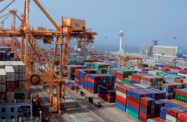Saudi Arabia is embarking on a massive programme to boost its logistics and cargo-moving capacity as part of a much larger scheme to broaden the base of the economy and pave the way for future expansion.
The Kingdom has coastline along two of the world’s busiest and most important maritime transport lanes: the Red Sea, which is linked at its north-western end by the Suez Canal to the Mediterranean, and the Gulf, through which much of the region’s oil and gas exports are shipped. To make the most of this geographical advantage, and to help meet the increased transport needs of its expanding economy, Saudi Arabia is upgrading facilities at a number of its main ports, while developing at least two new cargo centres along the Red Sea coast. The schedule for port expansion was stepped up as part of the government’s $384bn investment programme, announced last August.
While ports will be one of the main beneficiaries of the government’s infrastructure investment programme, the expansion of seaborne cargo-handling capacity will also be vital. The state investment plans call for the construction of up to 500,000 housing units; a vast network of highways and the expansion of the national rail system; and a large number of new state buildings, including hospitals, schools and universities. In addition, the coming years will see extensive investments by both the government and the private sector as part of a long-term effort to diversify the economy, with funds being directed into enterprises in the manufacturing, commercial and services industries. This scheme will require millions of tonnes of materials, much of which will need to be imported, necessitating an increase in the size of existing ports as well as the development of new ones.
Of the new projects, the port at King Abdullah Economic City (KAEC) is among the largest. It will be the centrepiece for a new city of some 2m people being built 120 km to the north of Jeddah on the Red Sea. A joint venture between Dubai developer Emaar Properties and Saudi investors, KAEC has been affected to a degree by the global economic crisis, with investor pick-up slower than originally hoped. In light of this, the Saudi government has moved to hasten the pace of activity, offering the venture a $1.3bn loan at the end of May, with analysts taking the move as a sign of confidence in the project, as well as an indicator of the importance attached to it.
Though some of the developments on land have progressed less quickly than planned, work on the port itself is on schedule, with cargo-handling operations due to commence in 2013. In late May, officials announced that the first phase of dredging the harbour, including clearing the entry channel to the port and the turning basin, had been completed, with some 3m cu metres of material removed. Stage two, which involves further dredging and the construction of berths, cargo storage areas and administrative buildings, is already under way.
According to Fahd Al Rasheed, the managing director and CEO of Emaar, the Economic City and member of the board of the Ports Development Company, the port’s proximity to Saudi Arabia’s industrial heartland will be a major selling point for investors. In its initial stage, the port will have more than 1000 metres of conventional berthing space and 10 container berths, giving it the capacity to handle some 5m containers a year, a figure that will rise in later years as demand grows.
The planned increase in overall capacity will help offset a continued rise in demand, with Saudi Arabia’s existing ports moving just over 154m tonnes of freight in 2010, 8% up on the previous year, according to the Saudi Ports Authority. The first quarter of this year saw cargo volume continue to climb, with a 4.2% rise over the same period in 2010.
By far the Kingdom’s largest port, the Jeddah Islamic Port, which handles more than 70% of the country’s container freight and one-third of the total, is also in line for a further expansion, with this coming after its capacity was doubled with the opening of a new terminal last year. Plans are in the works to expand its cargo facilities by up to 50%, with the longer-term target of increasing capacity from 6.5m to 13m containers by 2020.
While the Kingdom’s large-scale port expansion is in part driven by its ambitions to be a leading regional logistics centre, Saudi Arabia also has to provide for the needs of a rapidly expanding population, which is projected to top 40m by 2020, up from around 27m at present. The recent decision to scale back production in its heavily subsidised agricultural sector, including phasing out domestic wheat production completely, will also translate into growing import volumes.
As well as a point of departure for its own diversifying exports, with import volumes likely to continue to rise, Saudi Arabia’s ports will increasingly be the nation’s lifeline to the world.

